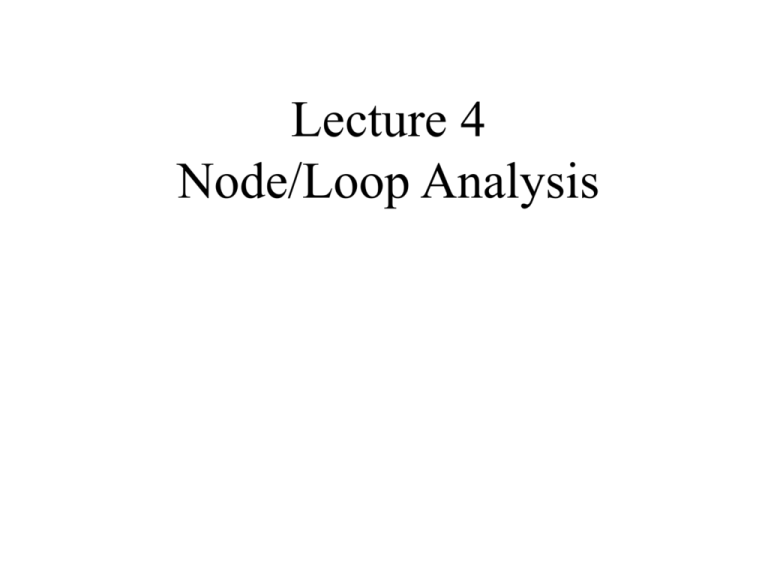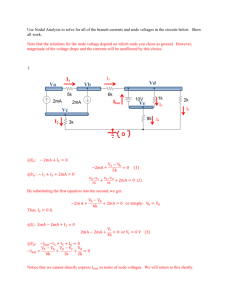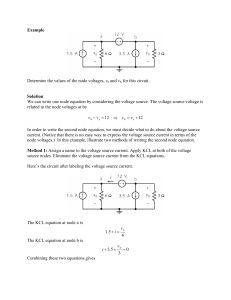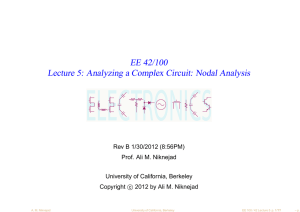Lecture 04
advertisement

Lecture 4 Node/Loop Analysis Although they are very important concepts, series/parallel equivalents and the current/voltage division principles are not sufficient to solve all circuits. Node Voltage Analysis Node Voltage Analysis v1 v s v2 v1 v2 v2 v3 0 R2 R4 R3 v3 v1 v3 v3 v2 0 R1 R5 R3 Example 2.6 v1 v1 v 2 is 0 R1 R2 v 2 v1 v2 v 2 v3 0 R2 R3 R4 v3 v3 v2 is R5 R4 Exercise 2.6 v1 v2 v1 v3 ia R2 R1 v2 v1 v2 v2 v3 0 R2 R3 R4 v3 v2 v3 v1 v3 ib 0 R4 R1 R5 Exercise 2.8 Exercise 2.8 V1 10 V1 V1 V2 0 5V1 50 2V1 V1 V2 0 8V1 V2 50 2 5 10 V2 10 V2 V1 V2 0 V2 10 V2 V1 2V2 0 V1 4V2 10 10 10 5 8V1 V2 50 8V1 32V2 80 31V2 130 130 31 4.19 V2 V1 4V2 10 6.77 Exercise 2.9 Exercise 2.9 v1 v3 v1 v1 v2 0 v1 v3 4v1 2v1 2v2 0 20 5 10 v2 v1 v2 v3 10 0 v2 v1 2v2 2v3 100 0 10 5 v3 v3 v1 v3 v2 0 2v3 v3 v1 4v3 4v2 0 10 20 5 7v1 2v2 v3 0 v1 3v2 2v3 100 v1 4v2 7v3 0 Supernodes Circuits with Voltage Sources We obtain dependent equations if we use all of the nodes in a network to write KCL equations. v1 v1 15 v2 v2 15 0 R2 R1 R4 R3 Use KVL for a second independent equation: v2 v1 10V Exercise 2.11 KVL: v1 10 v2 0 KCL for supernode at 10V source: v1 v1 v3 v2 v 3 1 R1 R2 R3 KCL for node 3: v3 v1 v3 v 2 v3 0 R2 R3 R4 KCL for reference node: v1 v3 1 R1 R4 Node-Voltage Analysis with a Dependent Source First, we write KCL equations at each node, including the current of the controlled source just as if it were an ordinary current source. Example 2.9 v1 v 2 is 2i x R1 v2 v1 v2 v2 v 3 0 R1 R2 R3 v3 v 2 v3 2i x 0 R3 R4 Example 2.9 Next, we find an expression for the controlling variable ix in terms of the node voltages. v3 v 2 ix R3 Example 2.9 Substitution yields: v3 v 2 v1 v2 is 2 R1 R3 v2 v1 v2 v2 v 3 0 R1 R2 R3 v3 v 2 v3 v3 v 2 2 0 R3 R4 R3 Node-Voltage Analysis 1. Select a reference node and assign variables for the unknown node voltages. If the reference node is chosen at one end of an independent voltage source, one node voltage is known at the start, and fewer need to be computed. 2. Write network equations. First, use KCL to write current equations for nodes and supernodes. Write as many current equations as you can without using all of the nodes. Then if you do not have enough equations because of voltage sources connected between nodes, use KVL to write additional equations. 3. If the circuit contains dependent sources, find expressions for the controlling variables in terms of the node voltages. Substitute into the network equations, and obtain equations having only the node voltages as unknowns. 4. Put the equations into standard form and solve for the node voltages. 5. Use the values found for the node voltages to calculate any other currents or voltages of interest. Exercise 2.12(a) v2 v1 10V v2 10 v1 v1 v2 v1 v1 v2 1 v1 2(10 v1 ) 10 10 5 3v1 10 10 20 v1 v2 3 3 v2 4 ia 1.33 A 5 3 Exercise 2.12(b) v1 25 v1 v1 v2 0 10 10 20 v2 v2 v1 v2 25 0 20 20 5 v1 13 .79V v2 18 .97V v1 v2 ib 20 0.259 A v1 v2 Exercise 2.13(a) v1 v1 10 v1 2i x 2v1 10 10 i x 5 5 10 v1 ix 2v1 20 10 i x 5 20 i x 10 i x 0.5 A Exercise 2.13(b) v1 v1 2i y 3 0 v2 5 2 v2 v2 2i y 3 0 5 10 v2 iy i y 2.31 A 5 v1




